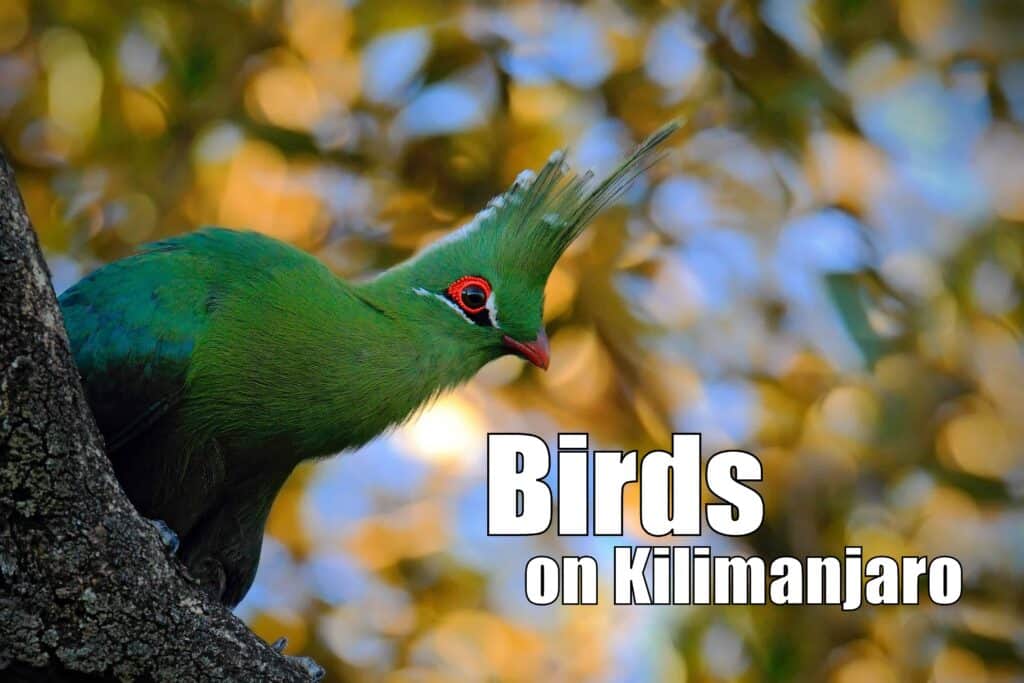
Sub-Sarahan Africa is a birder’s paradise, and the region surrounding Mount Kilimanjaro is no exception to this rule. Ethereal bird calls echo through the trees as you glimpse about, hoping to catch sight of the dazzling variety of feather and wing fluttering through the canopy. Opportunities to see some of the beautiful species tropical Africa has to offer will be most abundant in the areas surrounding your hotel and as the trail winds through the cloud forest. Home to a diverse population of tropical African birds, the cacophony of songs emanating from the trees will provide a magical soundtrack for the surrounding jungle scene.
To wet your whistle, here are a few of our favorite local species:
Turacos, known as the Lourie further south, can be spotted flitting through the forest where they consume mainly fruit and plant matter while eating a more insect-based diet as chicks. Social birds by nature, Turacos travel in flocks of around ten to twelve individuals. In the region surrounding Kilimanjaro, sightings of Hartlaub’s Turaco, Schalow’s Turaco, and the Violet Crested Turaco are all possible.
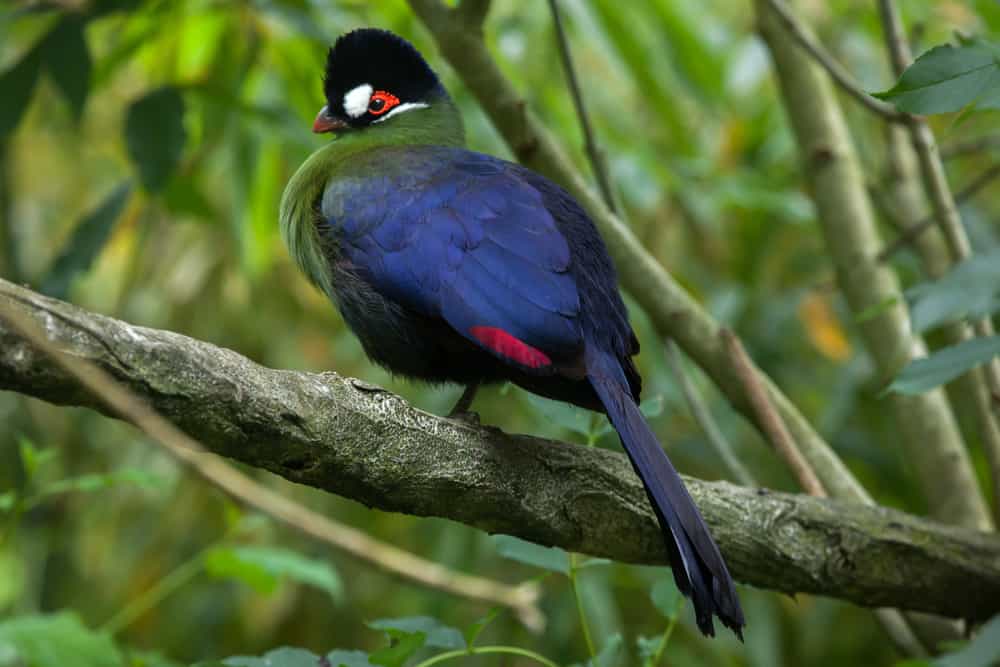
Hartlaub’s Turaco was named to commemorate German physician and ornithologist Gustav Hartlaub. The black crest on its head, red surrounding its eye, and white spot anterior to the eye make for a dramatic presentation. Green plumage decorates its breast while iridescent blue plumage covers its back. Hartlaub’s Turaco can often be identified as the dash of crimson on their underwings flashes brightly amongst a sea of forest green.
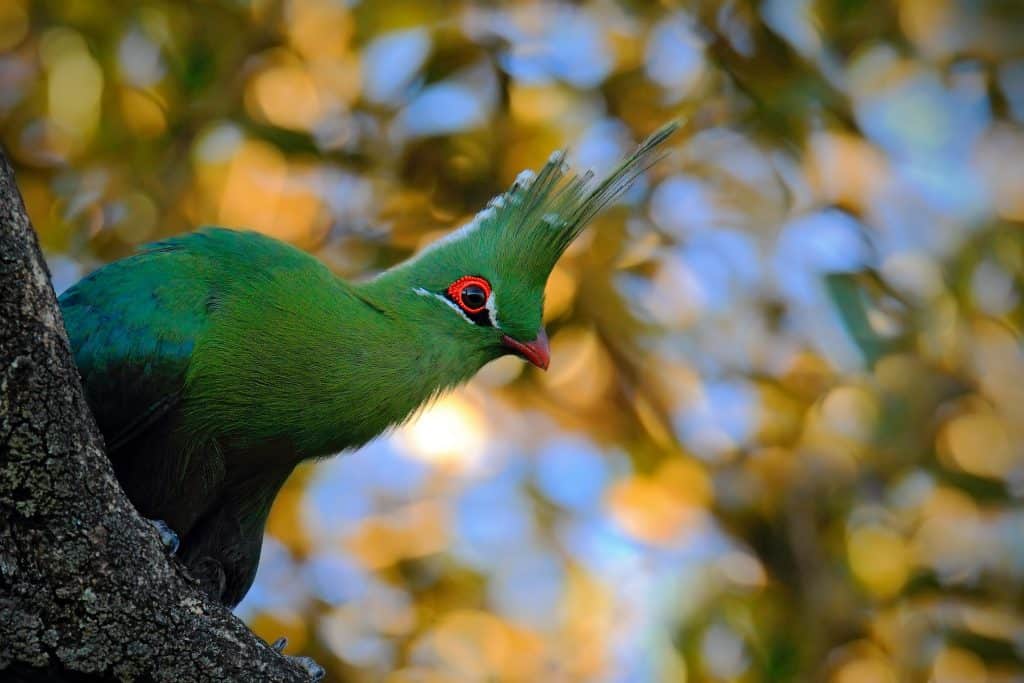
Schalow’s Turaco was named to commemorate a German banker and amateur ornithologist, Hermann Schalow. This frugivorous turaco is light for its species, weighing just over half a pound (270g), with a length of 15-17 inches. Jade green plumage covers most of its body and flows into the long, white-tipped crests upon its head. As its feathers near the tail, they fade to a dark, shimmering blue. It has a small, red beak and red skin surrounding its dark eyes. Compact, round wings with scarlet flight feathers make Schalow’s Turaco especially fit for short jaunts through the canopy. Monogamous pairs share incubation duties of 2 egg clutches lasting from 20-22 days and care for their offspring together. Within 4-5 weeks, hatchlings can fly.
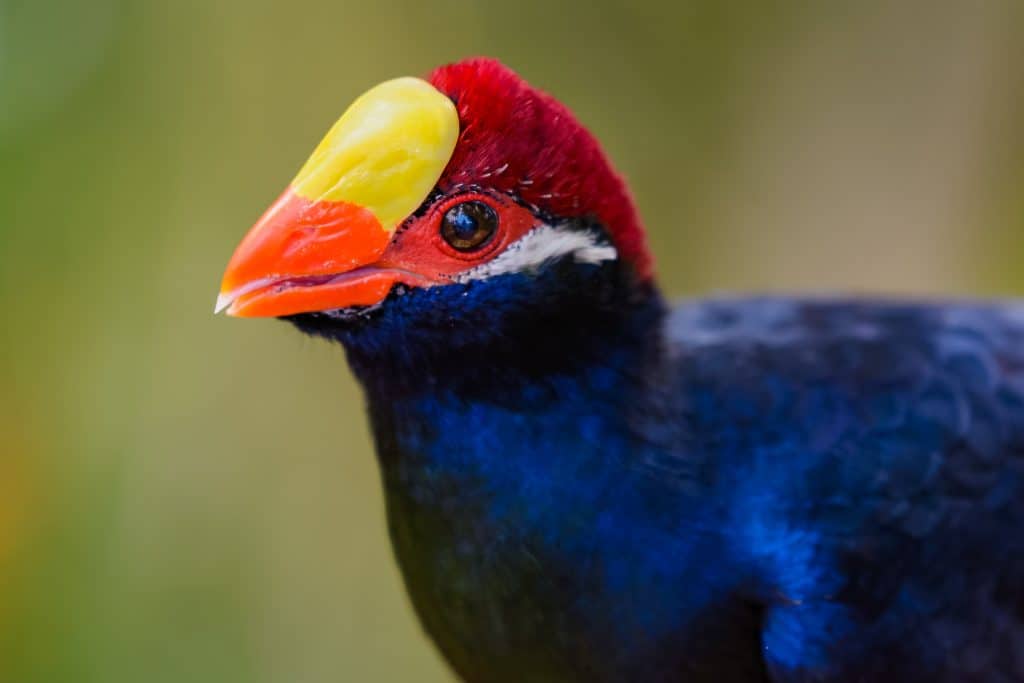
The unmistakable Violet Turaco is quite timid and often inconspicuous. Also known as the violaceous plantain eater, this large turaco is approximately 48 cm long (19 in), including a long violet tail and a thick, 4 cm (1.6 in), reddish-orange bill. It has a yellow forehead, chestnut crown, white ear coverts, and scarlet flight feathers that contrast with the rest of its violet plumage. Like other turacos, the violet turaco consumes mostly insects and plant matter. However, this brilliantly colored little fellow exhibits a particular preference for figs.
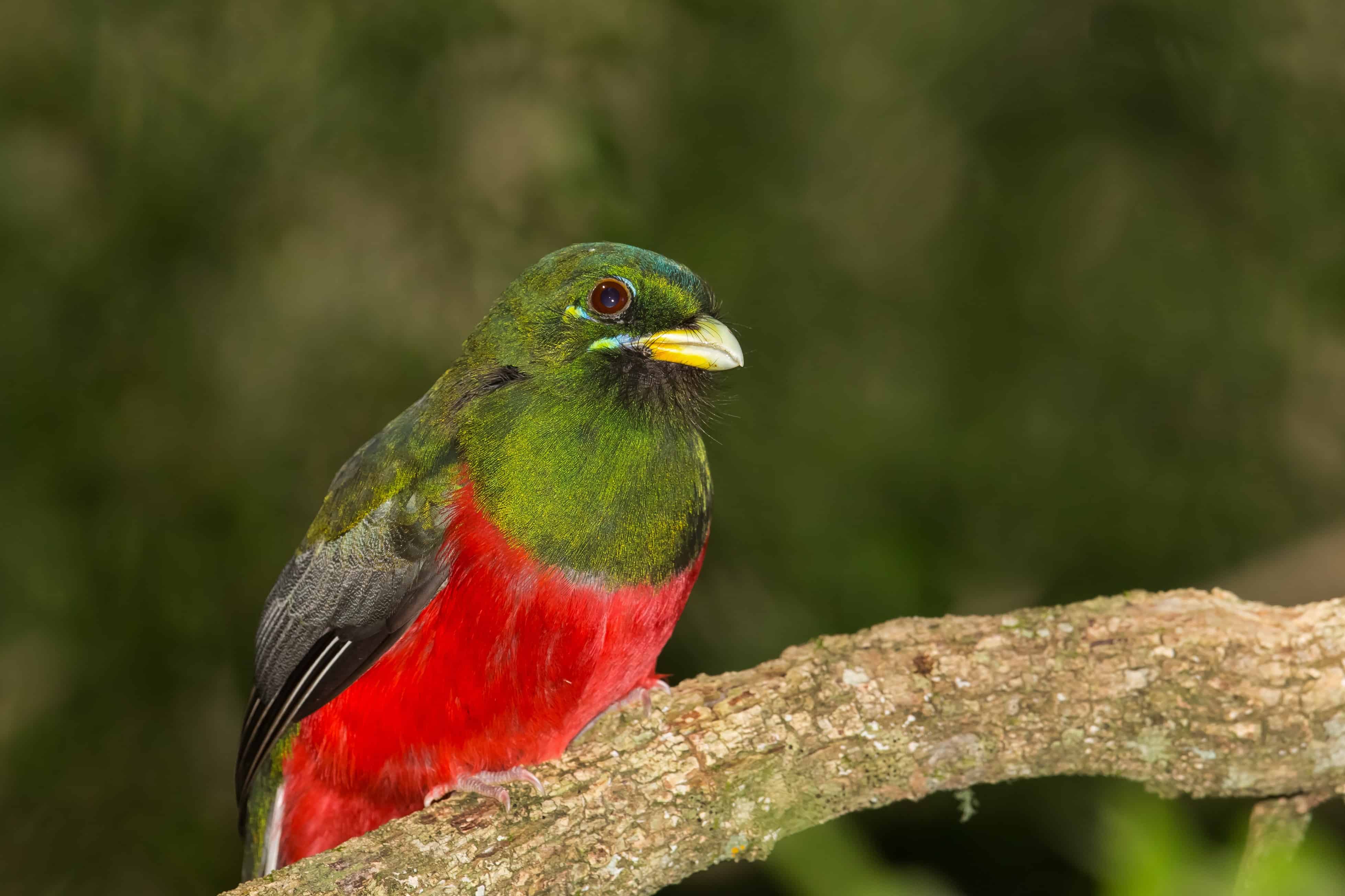
The Narina Trogon’s name commemorates the mistress of French ornithologist Francois Le Vaillant. He derived Narnia from a Khoikhoi word for “flower” because he had a difficult time pronouncing her given name. Deforestation has led to depletion of local numbers of this medium-sized (32-34cm long), amaranth and green species. Some populations are migratory, while others are sedentary. The sexes are dimorphic, with males exhibiting more dramatic coloring than the soft brown and dull red females. When attempting to attract mates or defend territory, males produce a low repeated hoot. The diet of the Narina Trogon consists of insects, rodents, and reptiles.
In Kilimanjaro’s cloud forest, you may also spy Hornbills as they traipse from tree to tree high in the canopy. Hornbills are omnivorous birds, feeding on fruits, insects, small birds, rodents, small reptiles, and centipedes. They usually live in pairs but have been known to roost in flocks of hundreds of individuals as well.
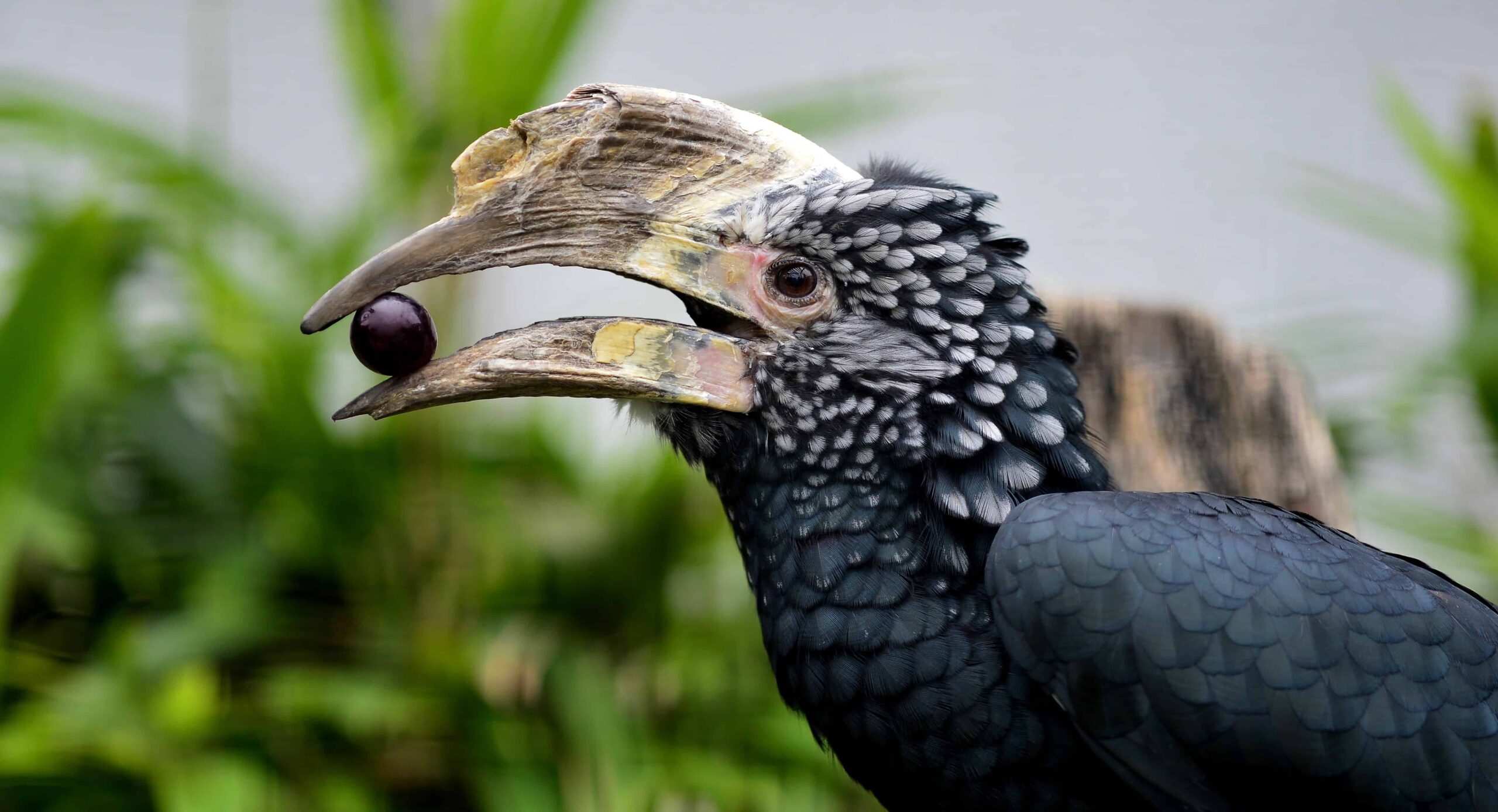
The Silvery-Cheeked Hornbill measures 75-80 centimeters (30-31 inches) in length and a has a large, cream-colored casque on the beak. Their head is silver-grey, and their plumage is iridescent black except for the lower back, rump, thighs and outer tail feathers, which are white. The male and female are similar, except the latter have a bit of reddish skin surrounding her eyes. Hornbills lay clutches of one-three eggs that they incubate for 40 days. Hatchlings remain with the parents for about 80 days.
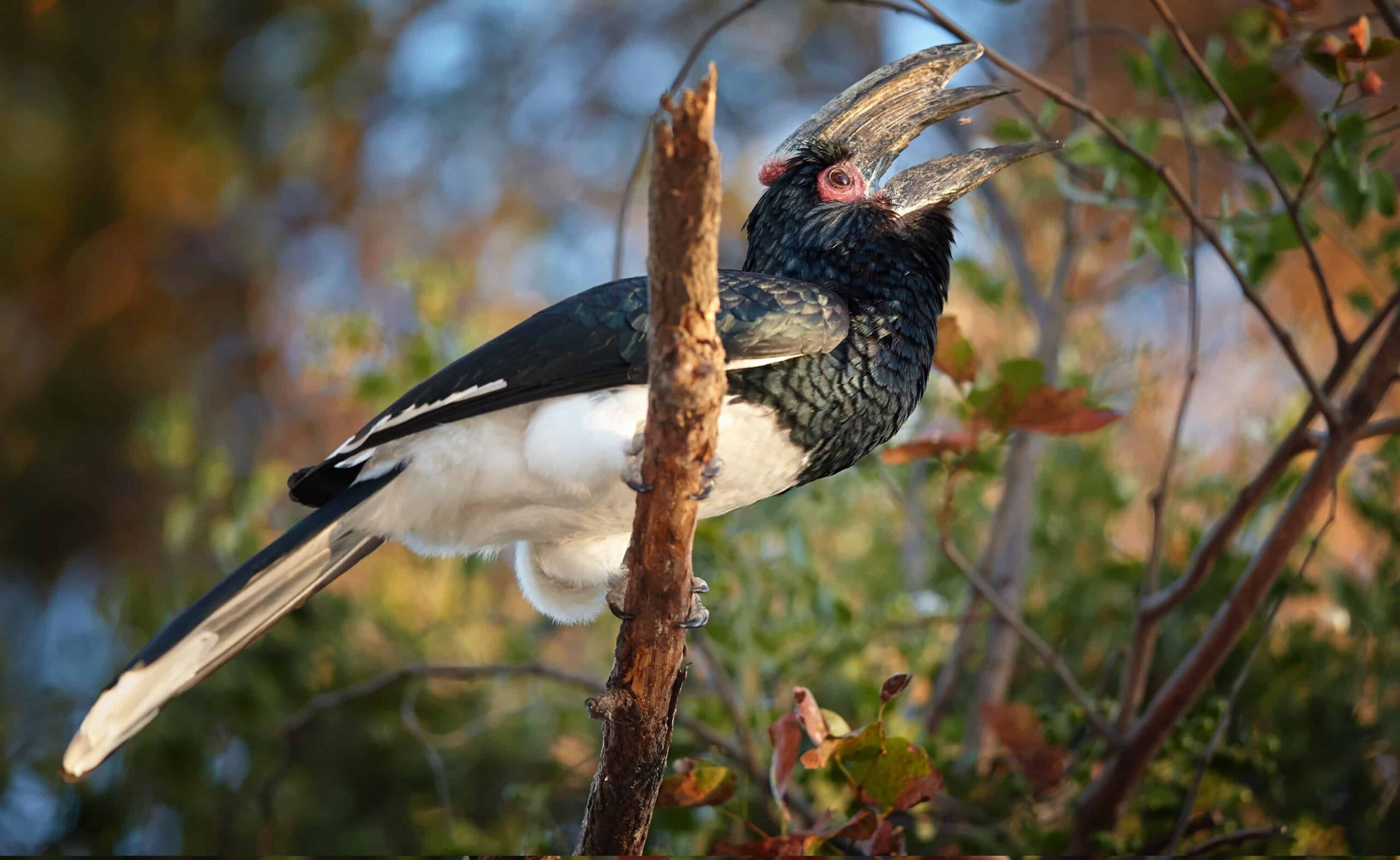
There have been occasional sightings of the Trumpeter Hornbill in the forest canopy as well. The Trumpeter is a medium-sized hornbill with a length between 58-65 centimeters (23-26 inches). It is quite similar to its Silvery-Cheeked relative; however, its entire back is black, it has a white belly, white underwing coverts, and red facial skin. The Trumpeter Hornbill is a gregarious bird known for its intelligence. When tamed, trumpeters are considered quite loving, and the can learn a variety of tricks.
Cuckoos are mostly solitary birds that seldom occur in pairs or groups. Shy in general, most birders hear cuckoos rather than see them. There are about 30 species of cuckoo, including the Coucal, most of which are insectivorous.
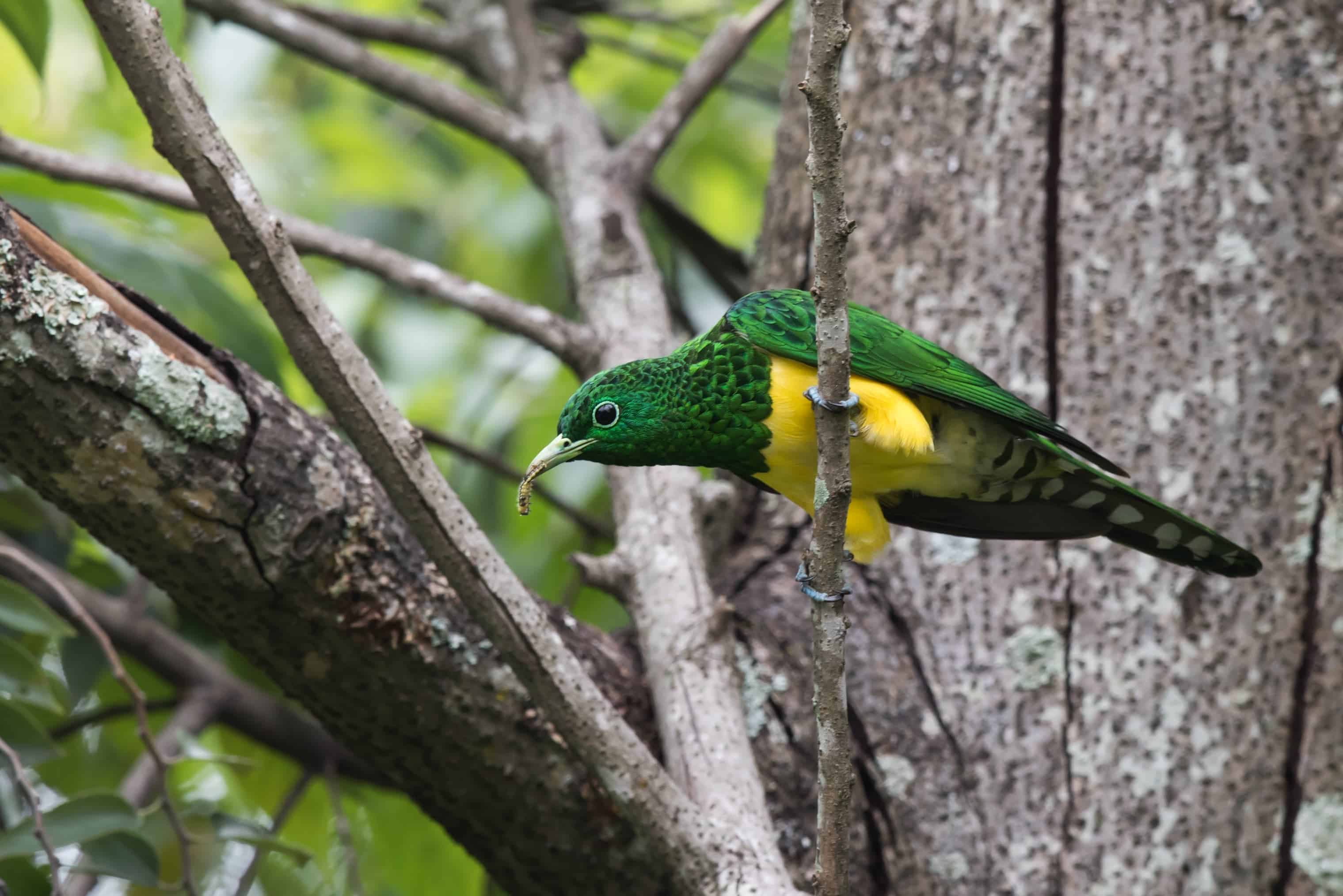
The African Emerald Cuckoo is an old world cuckoo, and like most old world cuckoos, a brood parasite. The female lays 19-25 eggs on average per breeding season in the nests of other species. Usually, the eggs of the cuckoo will hatch earlier than those of the host. As a result, the cuckoo’s chicks grow faster and often evict the eggs or young of the host species. Even though they do not need territory to feed fledglings, male cuckoos still maintain one to display to potential mates. Most of its foraging is done in the middle to top layers of the canopy. It is a dimorphic bird, with males having a green head and back with a yellow breast while females have barred green and brown backs and white chests. The Emerald Cuckoos call is a four-note whistle resembling “Hello Judy.”
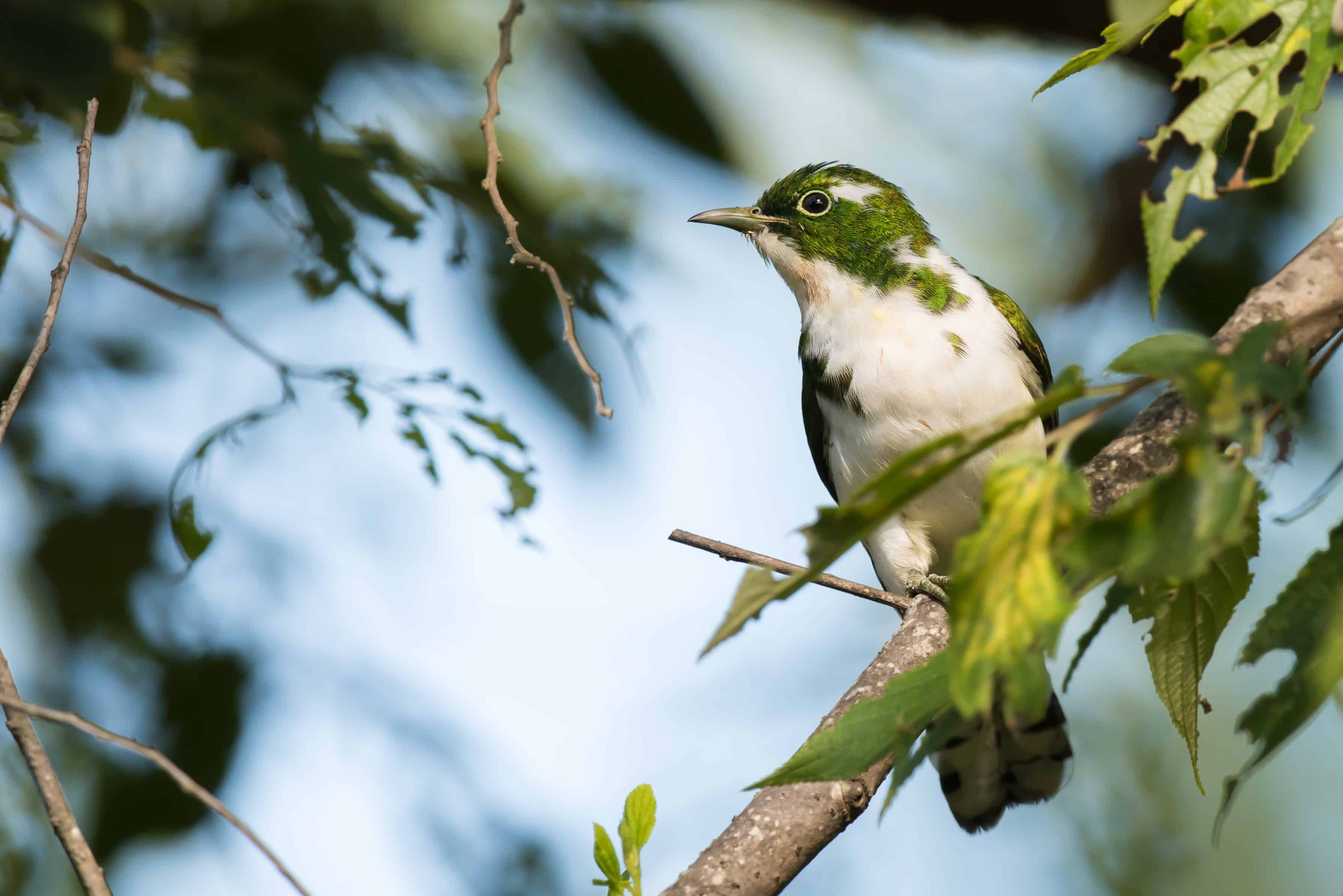
Klaas’s Cuckoo, like the Narina Trogon, was named by French explorer and ornithologist Francois Le Vaillant. Le Vaillant was the only colonial biologist to name bird species after local people. This one’s namesake was his Khoikhoi servant. These cuckoos range from about 16-18 cm in length. It is also sexually dimorphic, with males exhibiting green bodies with few markings and white underbellies, and females showing bronze-brown bodies with greenish wing coverts and faintly barred white underbellies. While flying, males appear mostly white, and females appear primarily brown.
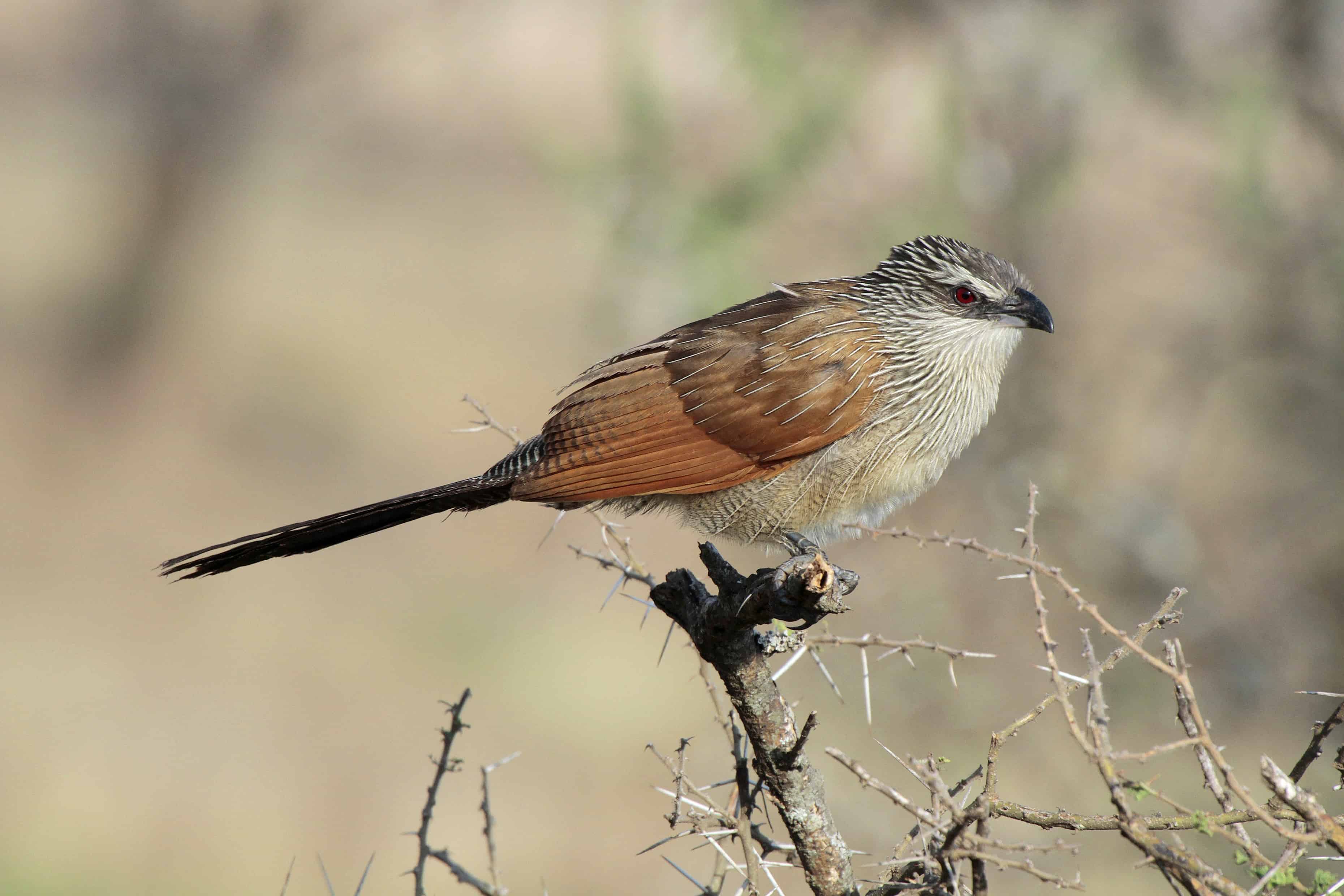
The White Brown Coucal or Lark-Heeled Cuckoo inhabits areas thick with cover afforded by dense shrubs and undergrowth. Although it is not a brood parasite, it does exhibit some unique reproductive traits in that the male provides most of the parental care. Medium-sized, this coucal grows to 36-42 cm (14-17 in) in length. The sexes are similar, with a blackish crown, nape and rump, rufous-brown backs, chestnut wings and a creamy white underbelly. Their tail is blackish with green and a white tip, and their eyes are red.
Kingfishers are enchanting little birds commonly found with blue and green colorations. These secretive, unobtrusive birds nest in burrows dug by both sexes in sandy soil banks or into a ground termite nest. Both parents care for the young.
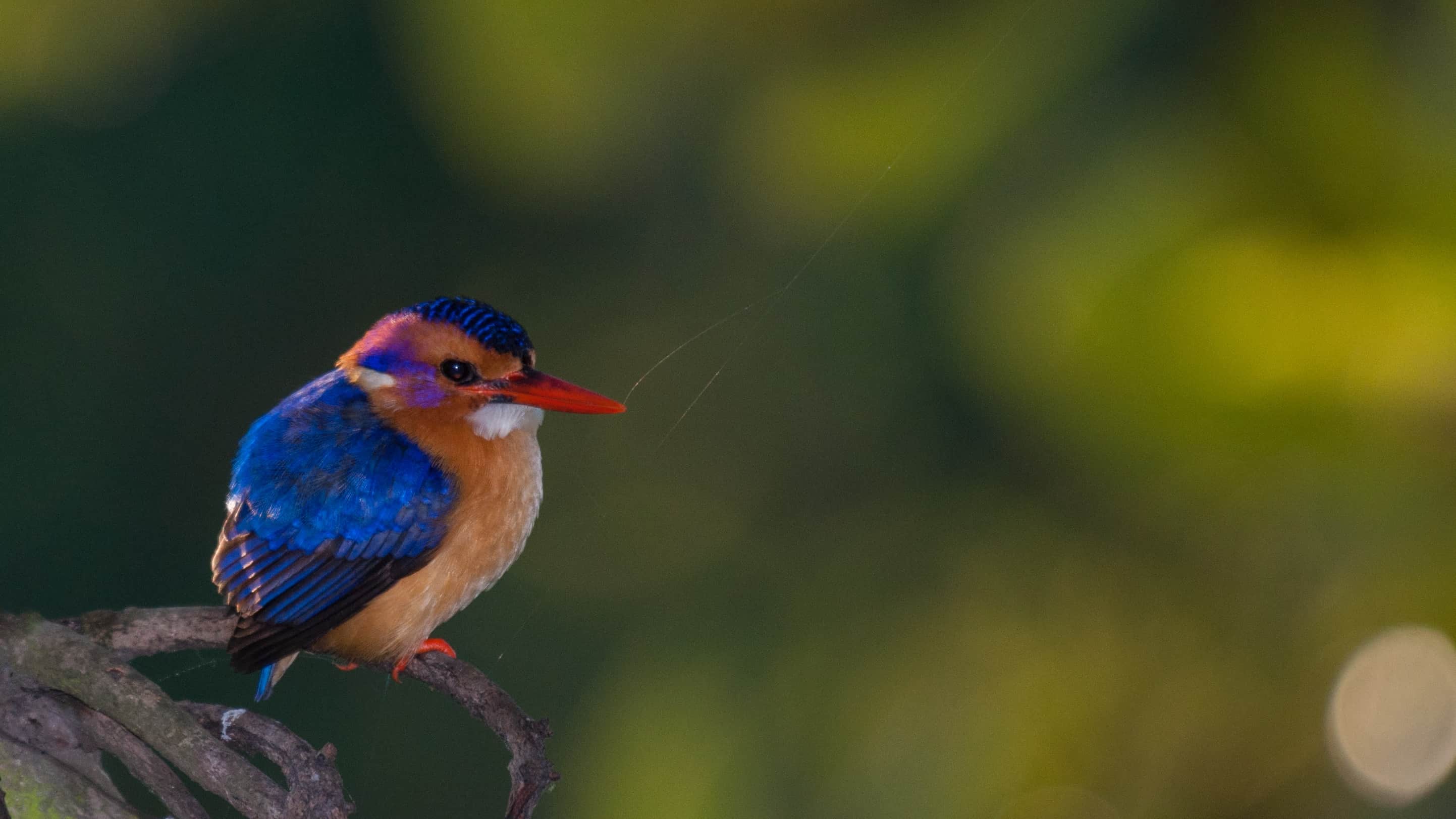
African Pygmy Kingfishers live in woodland, savanna and coastal forests either singly or coupled. Females lay four to six eggs at a time and can have several broods in a year. This kingfisher is not bound to water and feeds on insects, spiders, lizards, frogs and small crabs. The sexes are alike, both being small with rufous underparts and blue back plumage extending down the tail. Their smaller size and violet washed ear coverts distinguish it from the Malachite Kingfisher.
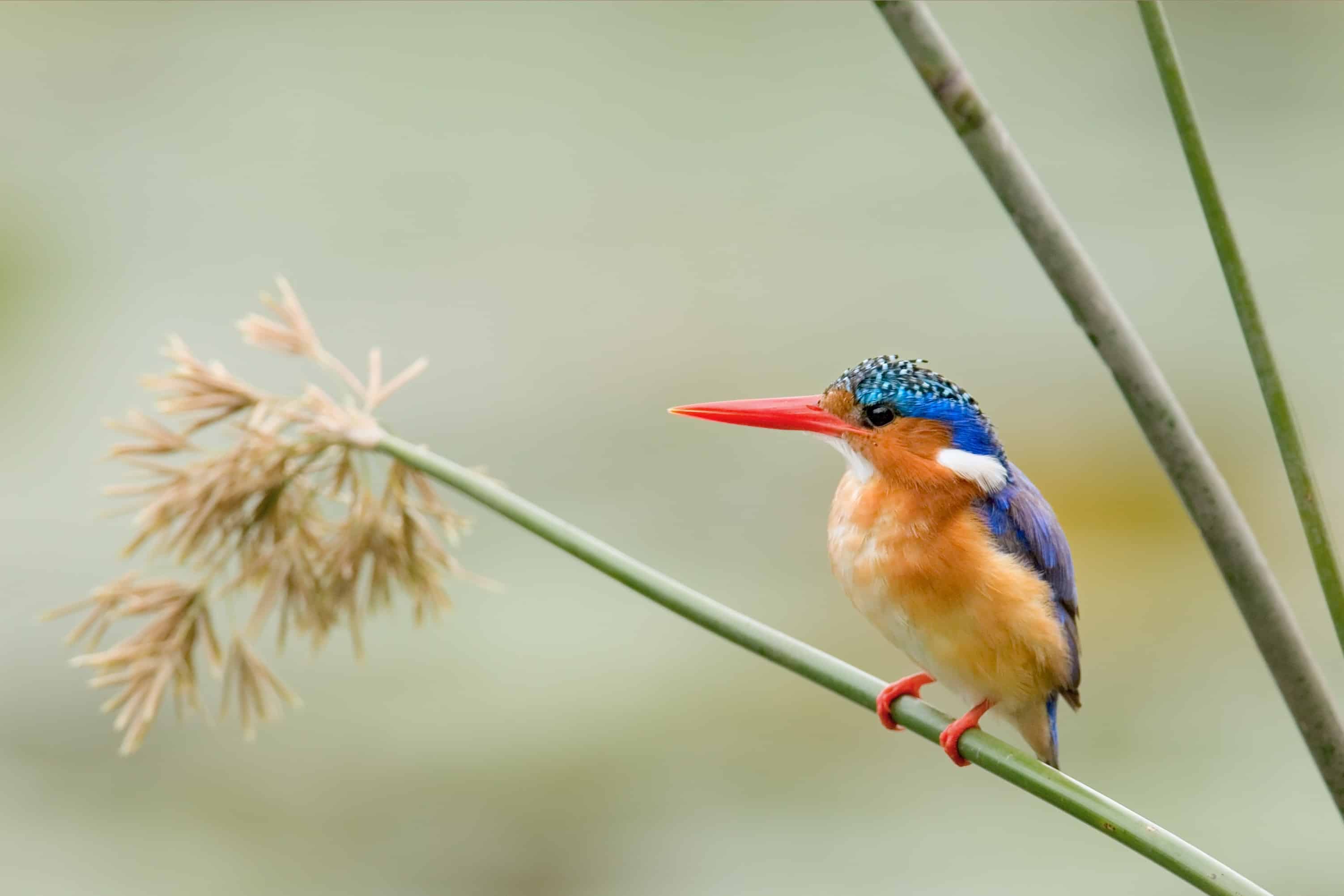
The Malachite Kingfisher has metallic blue upperparts and black banding with a pale or greenish-blue forehead. Both sexes are similar, with rufous a face, cheeks, and underbelly and white patches on the throat and rear neck sides. The bill is black in young adults, and red in adults and its legs are bright red. Tunnels near sandy water banks are their favorite nesting spots. Tiny, rounded wings, make for quick flying, as they whir by, a mere blur while catching small fish, insects, and crustaceans in the neighboring streams. To see a wild malachite kingfisher in action, please see the video below:
The adorable Cinnamon-Chested Bee-Eater lives in upland regions, usually between 1800 and 2300 m (5900-7500 feet). It dwells on the forest fringes, wooded hillsides, clearings, and gardens. Favorite snacks include honeybees, moths, butterflies dragonflies, beetles, and other flying insects.
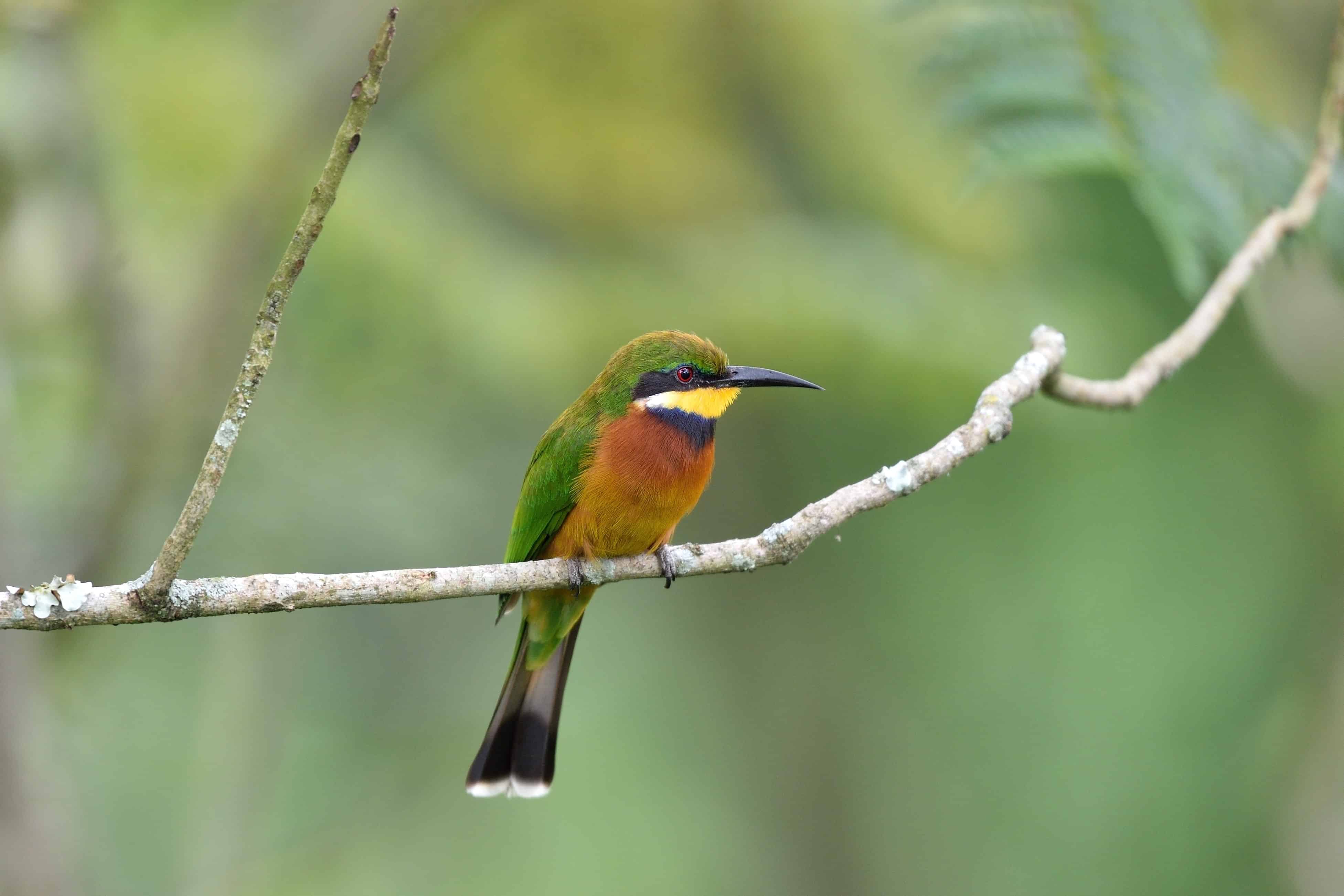
Cinnamon-chested bee-eaters are about 22cm in length (8.7 inches) and weigh 17-38 g (.6-1.34oz). Both sexes have a similar appearance, with bright green heads, backs, and tails. Their throat is yellow with a black outline, and their chest is cinnamon brown. When perched, the inner tail is blackish with an orange base and white tip. Their most common call is a short, high pitched “tseep tseep.”
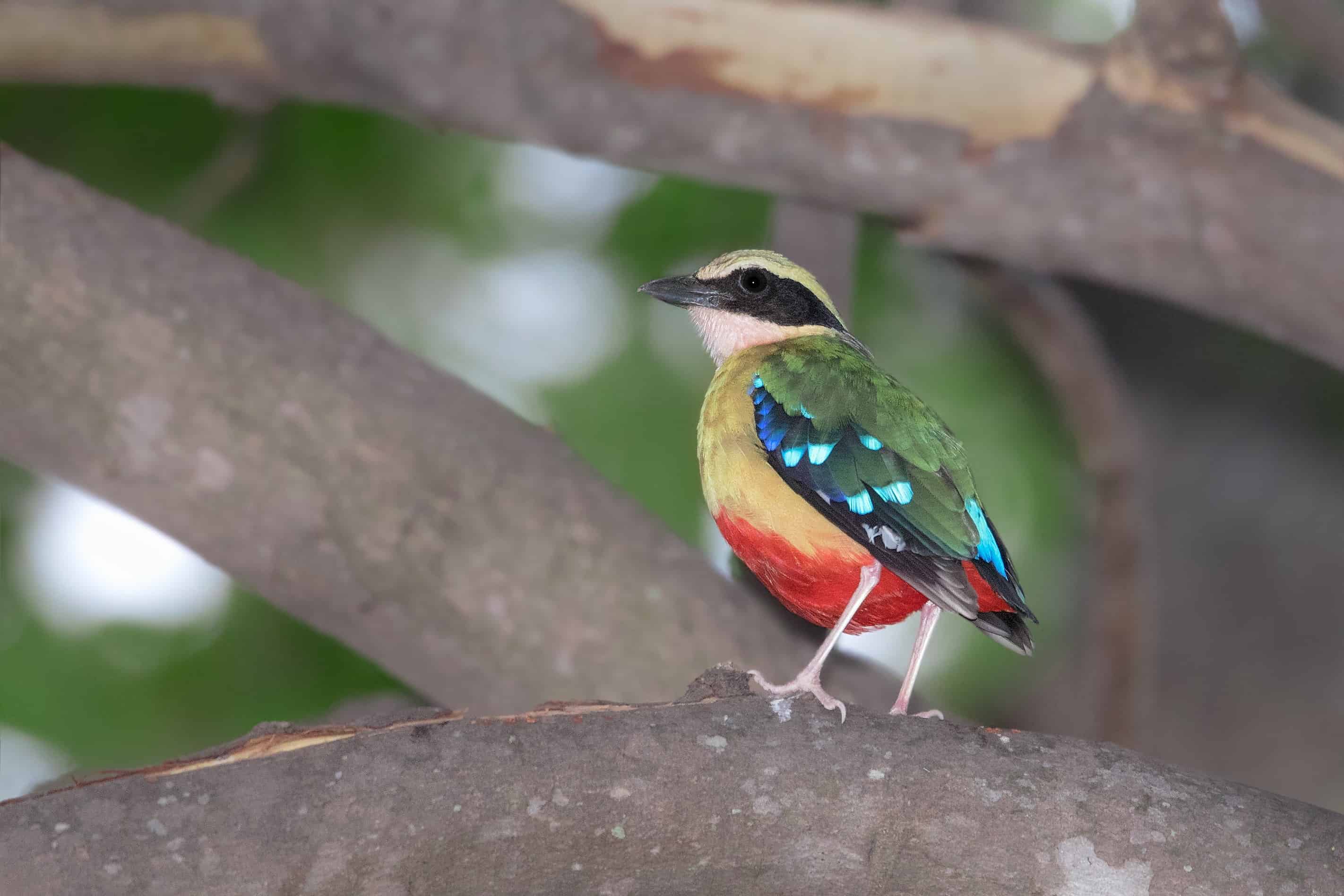
And last, but certainly not least, is the African Pitta. Often nicknamed the “holy grail” of African birds, this elusive specimen is hard to observe despite its brightly colored plumage and loud, explosive calls. The sexes are alike, with a solid black crown, face, and ear coverlets. Their throat is a pale salmon pink, and their flanks, breast, and neck are mustard yellow. Bits of black, turquoise and royal blue tip their deep green wings while crimson red decorates their underbelly and tail. African Pittas spend much of the morning moving about in quick hops while foraging through leaf litter for insects and mollusks. Following the rains, breeding pairs call and display from the mid-canopy. Consider yourself lucky if you spot one of these vibrantly colored beauties.
The Kilimanjaro Cloud Forest and surrounding area is home to many other fantastic bird species as well, including various types of sunbirds, flycatchers, shrikes, starlings, woodpeckers, chats, barbets, and more. These are just a few examples of tweets that a sharp-eyed observer might spy on their way to Kilimanjaro.
Read more about wildlife you can see while on safari here.
__________




























































